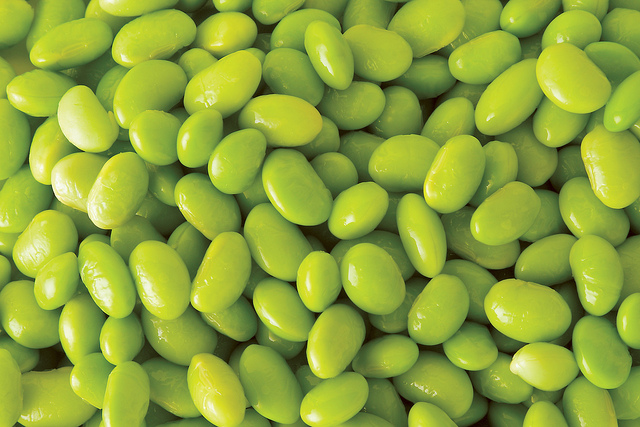Soybean

About
Soybeans are a species of legume native to East Asia. The plant is classed as an oilseed. It is an annual plant that has been used in China for 5,000 years as a food and a component of drugs. Soybeans and soybean products are often referred to simply as 'soy.' Soybeans are a good source of protein because they contain a significant amount of essential amino acids. Soybeans are the primary ingredient in many processed foods, including dairy product substitutes.
Information
Physical Description
Soy varies in growth and habit. The height of the plant varies from below 20 cm (7.9 in) up to 2 metres (6.6 ft). The pods, stems, and leaves are covered with fine brown or gray hairs. The leaves are trifoliolate, having 3 to 4 leaflets per leaf, and the leaflets are 6–15 cm (2.4"–5.9") long and 2–7 cm (0.79"–2.8") broad. The leaves fall before the seeds are mature. The inconspicuous, self-fertile flowers are borne in the axil of the leaf and are white, pink or purple.The fruit is a hairy pod that grows in clusters 3 to 5, each pod measuring 3–8 cm (1–3") long and usually containing 2–4 seeds of roughly 5–11 mm in diameter. Soybeans occur in various sizes, and in many hull or seed coat colors, including black, brown, blue, yellow, green and mottled. The hull of the mature bean is hard, water resistant, and protects the cotyledon and hypocotyl (or "germ") from damage. If the seed coat is cracked, the seed will not germinate. The scar, visible on the seed coat, is called the hilum (colors include black, brown, buff, gray and yellow). At one end of the hilum is the micropyle, a small opening in the seed coat that can help absorb water for sprouting. Remarkably, seeds such as soybeans containing very high levels of protein can undergo desiccation yet survive and revive after water absorption. A. Carl Leopold, son of Aldo Leopold, began studying this capability at the Boyce Thompson Institute for Plant Research at Cornell University in the mid 1980s. He discovered that soybeans and corn have a range of soluble carbohydrates that protect the seed's cell viability. Patents were awarded to him in the early 1990s on techniques for protecting "biological membranes" and proteins in the dry state.
Tasting Notes
Selecting and Buying
Preparation and Use
Soybeans can be broadly classified as "vegetable" (garden) or field (oil) types. Vegetable types cook more easily, have a mild nutty flavor, better texture, are larger in size, higher in protein, and lower in oil than field types. Tofu and soy milk producers prefer the higher protein cultivars bred from vegetable soybeans originally brought to the United States in the late 1930s. The "garden" cultivars are generally not suitable for mechanical combine harvesting because there is a tendency for the pods to shatter upon reaching maturity. Among the legumes, the soybean, also classed as an oilseed, is pre-eminent for its high (38–45%) protein content as well as its high (20%) oil content. Soybeans are the second most valuable agricultural export in the United States behind corn. The bulk of the soybean crop is grown for oil production, with the high-protein defatted and "toasted" soy meal used as livestock feed. A smaller percentage of soybeans are used directly for human consumption. Immature soybeans may be boiled whole in their green pod and served with salt, under the Japanese name edamame (枝豆, edamame?). In China, Japan, and Korea the bean and products made from the bean are a popular part of the diet. The Chinese invented tofu (豆腐 dòufu), and also made use of several varieties of soybean paste as seasonings. Japanese foods made from soya include miso (味噌), nattō (納豆), kinako (黄粉) and edamame (枝豆). In Korean cuisine, soybean sprouts, called kongnamul (콩나물), are also used in a variety of dishes, and are also the base ingredient in doenjang, cheonggukjang and ganjang. In Vietnam, soya bean are used to make soybean paste- tương in the North with the most popular products are tương Bần, tương Nam Đàn, tương Cự Đà as a garnish of phở dish and gỏi cuốn dish), tofu (đậu hũ or đậu phụ or tàu hũ), soya sauce (nước tương, literally: soya water), soya milk (nước đậu in the North or sữa đậu nành in the South), đậu hũ nước đường (tofu sweet soup). The beans can be processed in a variety of ways. Common forms of soy (or soya) include soy meal, soy flour, soy milk, tofu, textured vegetable protein (TVP, which is made into a wide variety of vegetarian foods, some of them intended to imitate meat), tempeh, soy lecithin and soybean oil. Soybeans are also the primary ingredient involved in the production of soy sauce (or shoyu).









